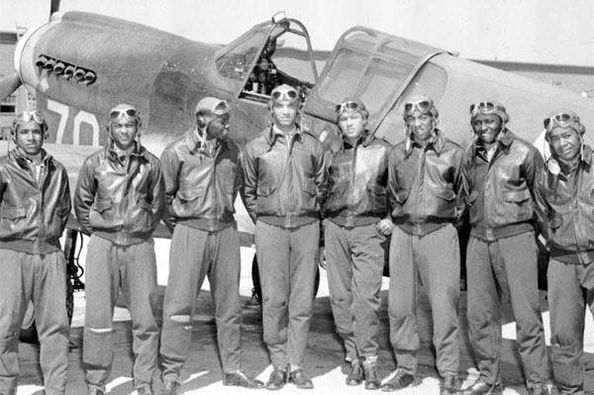GM – FBF – Today’s American Champions were The Tuskegee Airmen were a group of primarily African-American military pilots (fighter and bomber) and airmen who fought in World War II. They formed the 332nd Expeditionary Operations Group and the 477th Bombardment Group of the United States Army Air Forces. The name also applies to the navigators, bombardiers, mechanics, instructors, crew chiefs, nurses, cooks and other support personnel.All black military pilots who trained in the United States trained at Griel Field, Kennedy Field, Moton Field, Shorter Field and the Tuskegee Army Air Fields. They were educated at Tuskegee Institute (latterly Tuskegee University), located near Tuskegee, Alabama.Of the 922 pilots, five were Haitians from the Haitian Air Force and one pilot was from Trinidad. It also included a Hispanic or Latino airman born in the Dominican Republic. The 99th Pursuit Squadron (later the 99th Fighter Squadron) was the first black flying squadron, and the first to deploy overseas (to North Africa in April 1943, and later to Sicily and Italy). The 332nd Fighter Group, which originally included the 100th, 301st and 302nd Fighter Squadrons, was the first black flying group. It deployed to Italy in early 1944. Although the 477th Bombardment Group trained with North American B-25 Mitchell bombers, they never served in combat. In June 1944, the 332nd Fighter Group began flying heavy bomber escort missions and, in July 1944, with the addition of the 99th Fighter Squadron, it had four fighter squadrons.The 99th Fighter Squadron was initially equipped with Curtiss P-40 Warhawk fighter-bomber aircraft. The 332nd Fighter Group and its 100th, 301st and 302nd Fighter Squadrons were equipped for initial combat missions with Bell P-39 Airacobras (March 1944), later with Republic P-47 Thunderbolts (June–July 1944) and finally with the aircraft with which they became most commonly associated, the North American P-51 Mustang (July 1944). When the pilots of the 332nd Fighter Group painted the tails of their P-47s red, the nickname “Red Tails” was coined. The red markings that distinguished the Tuskegee Airmen included red bands on the noses of P-51s as well as a red rudder; the P-51B and D Mustangs flew with similar color schemes, with red propeller spinners, yellow wing bands and all-red tail surfaces.The Tuskegee Airmen were the first African-American military aviators in the United States Armed Forces. During World War II, black Americans in many U.S. states were still subject to the Jim Crow laws[N 1] and the American military was racially segregated, as was much of the federal government. The Tuskegee Airmen were subjected to discrimination, both within and outside the army.Before Tuskegee Airmen, African Americans were not allowed to become U.S. military pilots.In 1917, African American men attempted to become aerial observers, but were rejected. The rejections motivated African American men to enlist and train as military aviators. In 1939, The Air Corps and Public Law 18 bill officially passed – designated funds and equipment will be given to African Americans in aviation training.In 1941, the Army Air Corps and the United States Department of War created the 99th Pursuit Squadron — the first all-black flying unit. In Sept. 1941, the 99th Pursuit Squadron activated in Rantoul, Illinois at Chanute Field. In the same year, the airmen began the Tuskegee program at Tuskegee University.On Feb. 19, 1942, the Tuskegee Airmen were initiated into the United States Armed Forces and were able to fight in World War II.The Tuskegee Airmen painted their plane tails red for identification purposes, earning them the nickname Red Tails.The Airmen became known as the 332nd Fighter group and the 477th Bombardment Group of the United States Army Air Corps. Shortly after World War II, 992 men graduated from Tuskegee University – carrying out more than 200 bomber escort missions, damaging about 409 German planes, destroying over 900 rail cars and more.The Tuskegee Airmen left a legacy that will forever be known. Their courage and lack of fear made them earn history!A few achievements earned by the Tuskegee Airmen:Silver Star award96 Distinguished Flying Crosses14 Bronze Stars744 Air Medals8 Purple HeartsCongressional Gold MedalResearch more about these great American Champions and share it with your babies. Make it a champion day!

